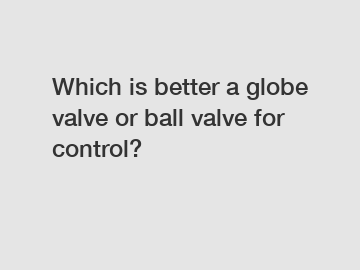Mar. 27, 2024
When it comes to selecting the right valve for control applications, there are various factors to consider. Globe valves and ball valves are two commonly used types of valves for control purposes, each with its own set of advantages and disadvantages. So, which one is better for control, a globe valve or a ball valve? Let's explore.
Globe valves have been a popular choice for control applications for many years. They are known for their ability to provide precise control over flow rates and are commonly used in industries such as oil and gas, chemical processing, and power generation. Globe valves have a linear motion design, which means that the flow of fluid is regulated by moving a disc up and down within the valve body. This design allows for fine control over flow rates and pressure, making globe valves ideal for applications that require precise adjustments.
One of the main advantages of globe valves is their ability to provide reliable and accurate control over flow rates. Because of their linear motion design, globe valves can be fine-tuned to provide the exact flow rate required for a given application. This level of precision is crucial in industries where even the smallest deviations in flow rates can have significant consequences.

Additionally, globe valves are known for their ability to handle high-pressure and high-temperature applications. Their robust design and sturdy construction make them ideal for controlling the flow of fluids in demanding environments. Globe valves are also versatile and can be used with a wide range of fluids, making them a popular choice for various industries.
On the other hand, ball valves are also commonly used for control applications. Ball valves have a simple design, consisting of a spherical disc with a hole in the middle that rotates to control the flow of fluid. Ball valves are known for their quick operation and tight shut-off capabilities, making them ideal for applications where fast response times are required.
One of the main advantages of ball valves is their low maintenance requirements. Because of their simple design, ball valves are less prone to wear and tear compared to globe valves. This means that ball valves require less frequent maintenance and can provide reliable performance over a long period of time.
However, ball valves are not as effective at providing precise control over flow rates as globe valves. The rotating motion of the disc in ball valves can make it challenging to achieve the same level of precision as with globe valves. This may be a limiting factor for applications that require extremely precise control over flow rates and pressure.
In conclusion, both globe valves and ball valves have their own set of advantages and disadvantages when it comes to control applications. Globe valves are known for their precise control over flow rates and ability to handle high-pressure and high-temperature applications. On the other hand, ball valves are quick to operate and have low maintenance requirements.
Ultimately, the choice between a globe valve and a ball valve for control will depend on the specific requirements of the application. If precise control over flow rates is crucial, a globe valve may be the better option. On the other hand, if fast response times and low maintenance are priorities, a ball valve may be more suitable.
Regardless of the type of valve chosen, it is important to work with a reputable valve manufacturer to ensure that the valve meets the specific requirements of the application. By selecting the right valve for control, industries can ensure optimal performance and efficiency in their operations.
If you want to learn more, please visit our website China hvac non rising stem cast iron company, China forged steel 20k angle valves company, China hvac non rising stem cast iron manufacturer.
If you are interested in sending in a Guest Blogger Submission,welcome to write for us!
All Comments ( 0 )